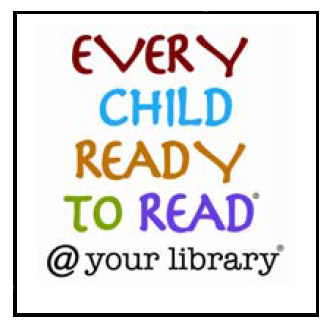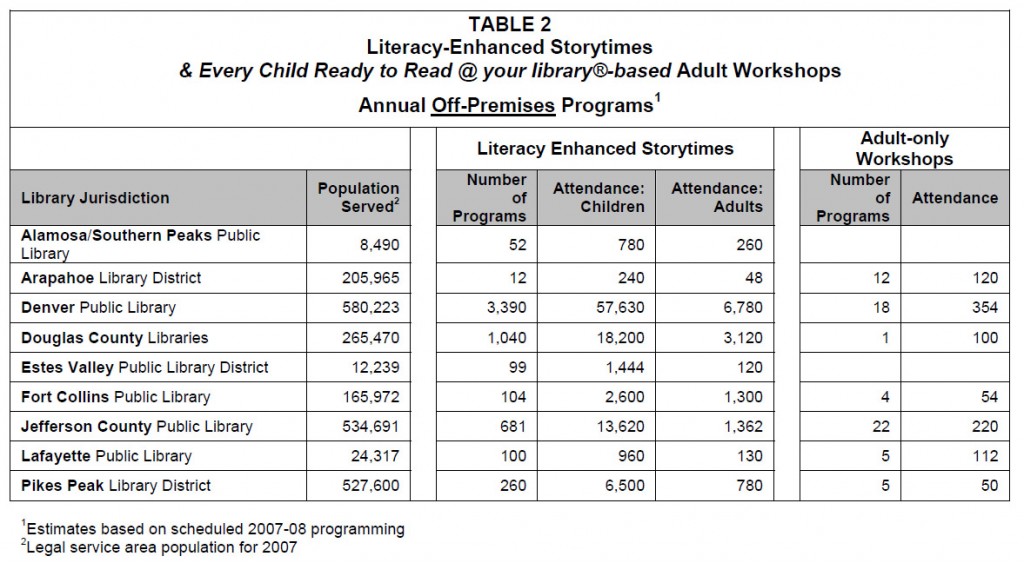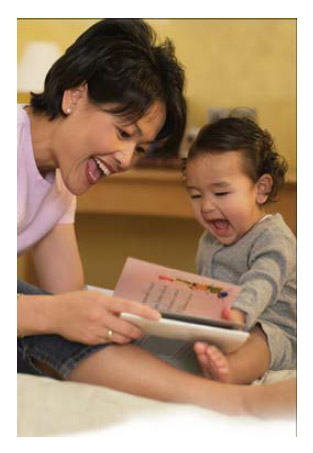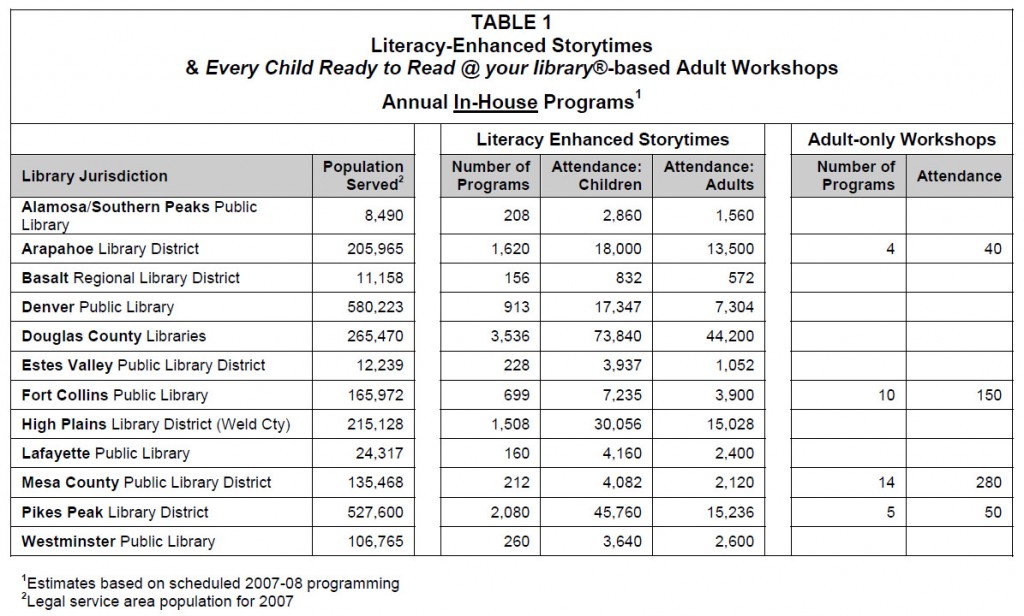 Inspired by concerns about young children’s school readiness, the Colorado State Library (CSL), has provided early literacy (pre-reading) program-development support to public libraries statewide since 2004. This support has included staff skills-training workshops, (based on the PLA/ALSC program Every Child Ready to Read @ your library® [ECRR]),[note]Every Child Ready to Read @ your Library® is a joint program of the Public Library Association and the Association for Library Services to Children, divisions of the American Library Association. Every Child Ready to Read® @ your library® is a registered trademark and is used with permission. Program information can be accessed at: http://www.ala.org/ala/alsc/ecrr/ecrrhomepage.cfm.[/note] grant funds, research reports, coalition building, and use of an e-list that helps practitioners share best practices and seek guidance from one another. (See Library Research Service publications: Fast Facts #237, #239 and A Closer Look: Early Literacy Programs and Practices at Colorado Public Libraries. Accessible at: http://www.LRS.org.)
Inspired by concerns about young children’s school readiness, the Colorado State Library (CSL), has provided early literacy (pre-reading) program-development support to public libraries statewide since 2004. This support has included staff skills-training workshops, (based on the PLA/ALSC program Every Child Ready to Read @ your library® [ECRR]),[note]Every Child Ready to Read @ your Library® is a joint program of the Public Library Association and the Association for Library Services to Children, divisions of the American Library Association. Every Child Ready to Read® @ your library® is a registered trademark and is used with permission. Program information can be accessed at: http://www.ala.org/ala/alsc/ecrr/ecrrhomepage.cfm.[/note] grant funds, research reports, coalition building, and use of an e-list that helps practitioners share best practices and seek guidance from one another. (See Library Research Service publications: Fast Facts #237, #239 and A Closer Look: Early Literacy Programs and Practices at Colorado Public Libraries. Accessible at: http://www.LRS.org.)
Bolstered by these endeavors, numerous library jurisdictions around the state, both large and small, have expanded the depth and scope of their programming for children from birth to age 6. Such programming includes ECRR-based literacy enhanced storytimes (for children and their adult caregivers)[note]See Ghoting, S. & Martin-Diaz, P. (2005). Early Literacy Storytimes @ your library: Partnering With Caregivers for Success. Chicago: American Library Association.[/note] and adult-only ECRR workshops that provide early literacy research data and hands-on skill-building activities adults can use with children. One goal of both programming types is to help adult caregivers understand the roles they can play in the development of children’s reading readiness.
Six Pre-Reading Skills
During ECRR-based storytime programs and adult workshops, library personnel model activities that help children develop these skills:
- Print motivation
- Vocabulary
- Print awareness
- Letter knowledge
- Phonological awareness
- Narrative skills
Among the outgrowths of CSL’s initiative thus far, a task force called Colorado Libraries for Early Literacy (CLEL) came to fruition in January 2008; it now serves as an advisory group to CSL. Comprised of self-selected active early literacy providers from public libraries across the state, CLEL aims to strengthen children’s literacy through a combination of library services and community advocacy. The CLEL Steering Committee currently includes children’s services, training, and outreach staff from 13 different Colorado library jurisdictions.
This report provides baseline early literacy programming data from these 13 library jurisdictions. The data was collected by CSL from February through May of 2008 from people who provide early literacy services on behalf of these libraries. The numbers represent best estimates based on current and previous years’ activities as reported by those library personnel. The data itself is divided into two different tables based on programming location—in-house or off-premises (outreach).
Baseline Findings
ECRR-based literacy-enhanced programming is offered in communities of varying sizes around the state. Using 2007 figures, the 13 public library jurisdictions surveyed for this report range from “medium-small,” Alamosa/Southern Peaks Public Library (8,490), to the state’s largest, Denver Public Library (580,223). For 11 of these 13 library jurisdictions, in-house literacy-enhanced storytimes are the most prevalent of these types of programs.
In-House Programming
Table 1 looks at the numbers of programs and attendance figures per year for activities held on the library premises. It should be noted that some libraries host programs for community partners such as child-care groups or clients of social service agencies inside their libraries as well as off-premises.
For this report, literacy-enhanced storytimes are defined as having these 5 components:
- Literacy theme for the storytime, using at least 1 of the 6 pre-reading skills.
- Parents and/or caregivers invited to attend.
- Storytime leader models and communicates about early literacy skills.
- Selection of appropriate books/activities to promote use of a skill.
- Sharing of skill-oriented information by leader either verbally or with handout material.

In-House Literacy-Enhanced Storytime Programs: Nearly all of the libraries, 12 of the 13 jurisdictions, offer this type of programming. Session numbers per year range from 156 at Basalt Regional Library District to 3,536 at Douglas County Libraries. Child visits range from 832 (Basalt) to 73,840 (Douglas) per year. Adult visits per year range from 572 (Basalt) to 44,200 (Douglas).
In-House Adult-Only ECRR Workshops: Just under a third of the 13 libraries offer these workshops for a general parent/caregiver audience. Where offered, the frequency of these programs ranges from 4 (Arapahoe Library District) to 14 (Mesa County Public Library District) times per year. Estimated adult visits per year range from 40 (Arapahoe) to 280 (Mesa). Mesa provides their 14 workshops as part of a community partnership that serves teen moms.
Beyond the programming statistics shown in this table, several libraries provide special in-house adult ECRR workshops for specific constituencies including library volunteers and members of community groups not necessarily representative of a parent/caregiver audience (e.g. students seeking academic credit). While such programs serve to benefit children and adults in these communities, statistics for these specialized-audience in-house adult ECRR workshops are not covered here.
Off-Premises Programming
Table 2 looks at programs and attendance figures per year for activities provided by libraries at off-site venues (outreach). In some cases, these numbers represent outreach programming led by closely supervised library-trained volunteers. Off-premises programs frequently reach adults and children who might not otherwise avail themselves of public library services. Often, these are geared toward specific groups at specific locales such as a prison or a child-care facility.
“Very, very useful. Clarifies what we, as parents, should emphasize to increase our children’s love of books.” – Adult ECRR workshop participant, Arapahoe Library District

Off-Premises (Outreach) Literacy-Enhanced Storytime Programs: Nine of the 13 jurisdictions offer this programming. Where available, annual session numbers range from 12 (Arapahoe Library District) to 3,390 (Denver Public Library). Child visits range from 240 (Arapahoe) to 57,630 (Denver) per year. Adult visits per year range from 48 (Arapahoe) to 6,780 (Denver). Frequently, off-premises storytime programs are held in child-care environments where the ratio of children to adults tends to be higher than comparable statistics for in-house programming.
Off-Premises Adult-Only ECRR-based Workshops: Seven of the 13 jurisdictions offer these workshops for a general parent/caregiver audience. Where available, the frequency of program offerings ranges from 1 (Douglas County Libraries) to 22 (Jefferson County Public Library) per year. Estimated adult visits per year range from 50 (Pikes Peak Library District) to 354 (Denver Public Library).
“My son notices letters in the environment all the time now and points out the letters in the words he sees.” – Storytime-attending parent, Douglas County Libraries
Conclusion

The Colorado State Library collected these statistics to provide baseline knowledge about public library-based in-house and off-premises programming—both for children and for their adult caregivers—focused on children’s reading readiness. The data from these 13 library jurisdictions who have staff members serving on the CLEL Steering Committee provides us with a useful overview for understanding several common types of early literacy programming currently underway—as well as the frequency of and attendance at those activities.
In Colorado, such early literacy program offerings are not limited to these 13 libraries; other public libraries around the state enthusiastically provide these kinds of programs, too. Future collection of statistics will enable CSL and CLEL to better understand the availability and impact of early literacy activities. Through training, advocacy, and ongoing support, Colorado’s libraries are working collaboratively to foster and promote early literacy to benefit residents in all areas of the state.
